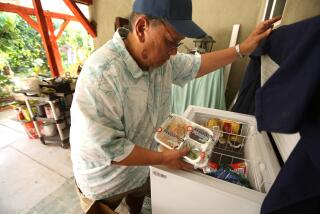Aid Program Still Trying to Help Poor Gain Independence
- Share via
Six months ago, Orange County officials established a new program designed to get people off welfare and into meaningful, good-paying jobs.
The program is called Greater Avenues for Independence, or Gain. It was expected to involve more than 5,000 aid recipients and to eventually cut welfare rolls by a third.
It would be more successful than other tried-and-failed workfare programs, authorities said, because for the first time, money would be made available for vocational classes, transportation and, most importantly, child care.
Based on data gathered from the first 4 months of operation, however, officials say it is still too early to determine the program’s effectiveness.
At the end of December, 763 people were in Gain; 12 had found jobs.
Fully 36% of the group was temporarily relieved from participating in the program due to a variety of factors, such as illness or a family crisis. In addition, more than a third of the participants were routed to remedial education classes before beginning a job search.
“It will take time before we can really tell what kind of success we are having,” said Dianne Edwards, director of adult employment programs for the county Social Services Agency. “What we can say is that we have had a smooth implementation, there have been no problems or surprises. The overall response has been positive; clients view it as something good and helpful.”
Edwards said that many participants will need extensive vocational training, so success in many cases will not be immediately apparent.
“We are basicly on schedule,” said Larry Leaman, Social Services Agency director. “The program only became operational countywide early this year. And we have learned from the experience of other counties that a high number of clients will need remedial training. The pipeline of this program tends to be longer than for most employment programs.”
Participation in the Gain program is required of all recipients of Aid to Families With Dependent Children who are between 16 and 65, are not disabled and do not have a child younger than 6. Under the state-imposed guidelines, all counties were required to have Gain programs in place by last Sept. 1. Orange County received $5.7 million for fiscal year 1988-89 to implement the program.
Social service officials say most aid recipients have not resented their mandatory participation in the program. Many so-called workfare programs have in the past been criticized by women’s and civil rights groups as unfair and ineffective for placing participants in low-paying, dead-end jobs and not providing child care.
But officials say the Gain program is designed to make jobs more attractive than welfare. Of the 12 job placements through December, many were clerical positions, Edwards said, although one participant got work as a pharmacist.
Officials say it will take a wage of at least $7.75 per hour to offset the support received by a single mother and two children on AFDC drawing food stamps and medical assistance.
“We are talking about clients who are the principal wage earners for a family,” said Leaman. “A minimum-wage job won’t allow families to even live at the poverty level. We want to place clients in jobs with a future.”
Still, some participants voiced mixed feelings about the program.
Eva Campos, a 53-year-old La Habra resident on AFDC, said she probably would not look for a job if not required to under Gain. Campos, a mother of 11 children with an 11-year-old daughter still living at home, said she has worked only briefly in the past--a part-time job in maintenance years ago--and is not sure she can successfully re-enter the work force.
“By the time you finish raising 11 kids you are so tired. You would think they would let me rest and not have to go out and get a job,” she said.
At a Gain orientation meeting recently, Campos spoke of her lack of self-confidence.
“I don’t think I will be able to learn, I don’t think I can make it,” she said to her case worker, Pama Tavernier. “My daughters scold me but I always think that if I get a job, on the first day I’ll do something wrong and be fired.”
Campos said she has an 11th grade education. She has no car and in any case says she doesn’t know how to drive. She has no phone and her main concern is being home when her daughter arrives from school.
Tavernier and Campos ultimately decided that she will be best served by entering remedial education classes which will also help her build confidence, Tavernier says, adding that Campos, who is bilingual and personable, already has at least two desirable traits.
Nevertheless, cases like Campos’ pose particularly difficult problems, social service officials concede.
“Many may initially have reservations about themselves, but if we can capitalize on their willingness to try we can go from there,” Edwards said. “And if the situation is the same when that 11-year-old is old enough to be off aid, then (Campos) would be required to work in our general relief program. It is far better to try to have an impact now because there are more resources we can apply through Gain.”
More to Read
Sign up for Essential California
The most important California stories and recommendations in your inbox every morning.
You may occasionally receive promotional content from the Los Angeles Times.














